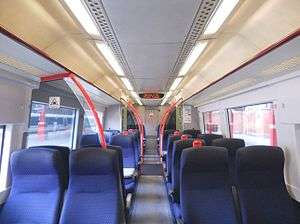British Rail Class 168
| British Rail Class 168 Clubman | |
|---|---|
|
Chiltern Railways 168214 at High Wycombe in 2015 | |
 The interior of a refurbished Class 168/1 | |
| In service | 20 May 1998 - present |
| Manufacturer | ADtranz, Bombardier |
| Family name | Turbostar |
| Constructed | 1998 - 2004 |
| Refurbishment |
2007 - 2008[1] 2013 - |
| Number built | 19 trainsets |
| Formation | 2/3/4 cars per trainset |
| Fleet numbers |
168001 - 168005 168106 - 168113 168214 - 168219 168321 - 168329 |
| Capacity |
204 seats (3-car unit) 272 seats (4-car unit) |
| Operator(s) | Chiltern Railways |
| Line(s) served | |
| Specifications | |
| Car body construction | Welded aluminium. Steel ends. |
| Car length | 23.62 m (77 ft 6 in) |
| Width | 2.69 m (8 ft 10 in) |
| Height | 3.77 m (12 ft 4 in) |
| Maximum speed | 100 mph (160 km/h) |
| Prime mover(s) | Diesel, one per car, MTU 6R 183TD |
| Power output | 422 hp (315 kW) per car |
| Transmission |
Voith Hydraulic T211rzze 2 axles driven per car |
| Safety system(s) |
ATP (168/3 excluded) AWS, TPWS, Tripcock system |
| Coupling system | BSI[2] |
| Track gauge | 1,435 mm (4 ft 8 1⁄2 in) standard gauge |
The Class 168 Clubman is a diesel multiple-unit (DMU) train used on services between London and the Midlands.
Description
The units were built in several batches from 1997 onwards. The first batch of units was classified 168/0 under TOPS and resembled the Class 165 units previously built by BREL York. The Networker-design cab was an interim solution pending the design of a completely new cab for further Turbostar batches. Subsequent builds, which are subclassed as 168/1 and 168/2, were constructed at the same time as the Class 170 Turbostar and thus are part of the Turbostar family of trains.
The first batch of Clubman carriages ordered by Chiltern Railways were the first units to be ordered by any train operating company since the privatisation of the UK industry in 1996. They were originally delivered as 3 car sets but were later lengthened to 4 car sets.
Seating
A typical Class 168 consists of 2+2 standard class seating throughout, arranged either round tables or in airline style seating with pull-down tables. The majority of seats are facing seats. The Class 168 is carpeted throughout with luggage racks, air conditioning, and two or more toilets per set (one for disabled users, with baby changing facilities). Passenger information systems are in fitted every car and on the outside of class 168/2 cars.
Variants
Three different variants of the 168 were produced - they are 168/0, 168/1 and 168/2 - both Classes 168/1 and 168/2 are actually of the same design as the Class 170 Turbostar DMU trains, mainly due to the redesigned cab ends. The nine Class 170s that Chiltern obtained from First TransPennine Express were converted to operate with the Class 168 fleet, and redesignated as Class 168/3.[3]
| Class | Operator | No. Built | Year Built | Cars per Set | Unit nos. |
|---|---|---|---|---|---|
| Class 168/0 | Chiltern Railways | 5 | 1998 | 4 | 168001 - 168005 |
| Class 168/1 | 8 | 2000 | 168106 - 168107 | ||
| 3 | 168108 - 168113 | ||||
| Class 168/2 | 6 | 2004 | 168214, 168218 - 168219 | ||
| 4 | 168215 - 168217 | ||||
| Class 168/3[3] | 9 | 2000 | 2 | 168321 - 168329 |
Operations
Network SouthEast (NSE) originally planned the Class 168 for their expansion of service on the Chiltern Main Line to Birmingham Snow Hill or New Street. These units were planned to have a higher top speed of 100 mph (160 km/h) and better acceleration than the Class 165 Network Turbo DMU trains.
In the event, privatisation intervened before NSE acquired any units; Chiltern Railways operates these units, in similar diagrams to those originally planned by NSE.
Gallery
 Class 168/0 No. 168003 at Marylebone. The Class 168/0 features the original cab design.
Class 168/0 No. 168003 at Marylebone. The Class 168/0 features the original cab design..jpg) Class 168/1 No. 168113 at Marylebone. This shows the final cab design.
Class 168/1 No. 168113 at Marylebone. This shows the final cab design. The interior of the MSO vehicle from a Chiltern Railways Class 168.
The interior of the MSO vehicle from a Chiltern Railways Class 168. Chiltern Railways Silver Mainline refurbished Class 168/1 No. 168106 at Marylebone.
Chiltern Railways Silver Mainline refurbished Class 168/1 No. 168106 at Marylebone. The interior of a Chiltern Railways Silver Mainline refurbished Class 168.
The interior of a Chiltern Railways Silver Mainline refurbished Class 168.
References
- ↑ Chiltern Railways. "Chiltern Railways: About us - Our train fleet". Archived from the original on 3 July 2010. Retrieved 2010-08-23.
- ↑ "System Data for Mechanical and Electrical Coupling of Rail Vehicles". Rail Safety and Standards Board. Archived from the original on 5 July 2008. Retrieved 2009-01-05.
- 1 2 Broadbent, Steve (4 March 2014). "Chiltern plots further expansion". Rail (769): 46–53.
Further reading
| Wikimedia Commons has media related to British Rail Class 168. |